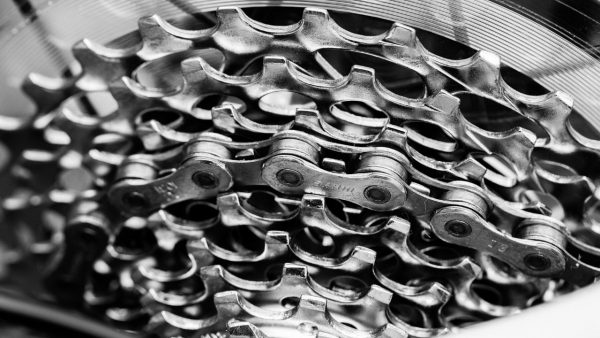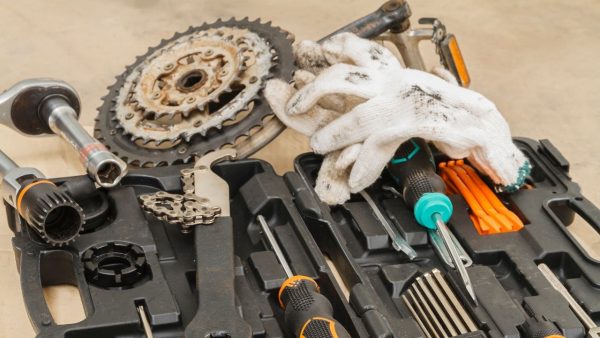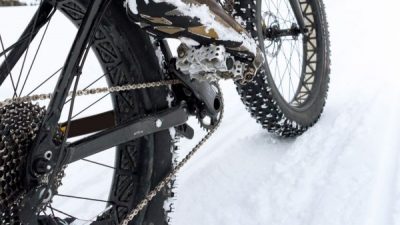Every single fat bike rider has a different plan once they get out there and start riding. For some, they want to make sure that they have the chance to go everywhere on trails, enjoying any different type of terrain out there. For others, it comes down to having the benefits of a wide tire, but also keeping things relatively lightweight so that speed is still achievable.
Gearsets add weight to any type of bike. Fat bikes are heavier in general, but intricate gearsets almost always come with fat bikes.
Do all fat bikes have gears? The vast majority of Fat bikes do have gears since riders want the chance to take them everywhere, but there are some options out there for those who don’t see the need.
Below, we take a look at why gears are considered a huge necessity for just about every rider. If used correctly, they make a significant impact for all levels of riders. We also take a closer look at why some people would opt for a single speed fat bike option.
Understanding Bike Gears
Since most people who buy fat bikes are going to have gears on their bike to use, it is important to understand the entire gearing system. The set up benefits the rider greatly, but only if the rider knows how to use gears properly.
For beginners, they might not know much of anything when it comes to gears, drive trains, maintenance, and more. Just a little bit of basic knowledge can go a long way.
Knowing the Main Components

The bike drivetrain consists of several different components that help with efficient pedaling every time. A conventional fat bike that has multiple speeds will contain the following:
– Cassette
This is the stack of gears mounted on the rear wheel. A good amount of fat bike riders like a cassette that allows for a wide range of gears. These can vary in size, especially on fat bikes. They just can’t be too big, or it becomes something that bulges out too much on a bike.
– Chain
The chain is what connects everything together. It links up with the chain rings that near the pedals. A chain might be a basic component, but it requires the most maintenance. If it is working as it should, everything else usually works well also.
– Derailleurs
A derailleur on a bike helps a chain go where it needs to, connecting cog to cog or chain ring to chain ring. This is important and shifting, because if the chain is not working correctly, it can mess up the entire bike. Just about every bike out there has a rear derailleur, but not all fat bikes are going to have a front derailleur.
– Shifters
These are what people use near the handlebars of a fat bike to change from gear to gear. There are many different variations of shifters, ranging from levers to twist grips. Most shifters operate with cables, and follow the same type of format. The right-hand shifter controls the rear derailleur, while the left-hand shifter controls the front derailleur. That means that slight adjustments come from the right hand, and bigger shift changes come from the left.
Gearshifting Tips
Shifting gears might seem pretty straightforward, but a few tips will go a long way towards having success on any surface. Once a person is comfortable shifting consistently, they can tackle just about anything.
Always Look Ahead
This is something that comes with practice, but every fat bike rider should be looking ahead and anticipating terrain before they hit it. If there is a pretty big hill coming up, shifting to a different gear after starting the climb is too late. A rider should be trying to shift gears before, helping to build up momentum and attack the hill head-on.
Not only does this help keep the bike going at a fast pace, but it helps an individual keep their bike in excellent working order. There is a chance of causing quite a bit of grinding if a person is shifting while putting too much pressure on the pedals. This doesn’t happen nearly as much if a person is thinking ahead and shifting before they need to.
Pick a More Comfortable Gear Over a Harder Gear Every Time
The basic tips for any fat bike rider is to be in the toughest gear possible while still moving at an efficient pace. The keyword here is efficient. Too many times, people try to push the situation by being in a hard gear and thinking that is always the best way to go.
When in between two gears, it makes more sense to drop to a more comfortable gear. It allows a rider to speed up the cadence a bit, build up momentum, and not put too much stress on the body.
There will be times during any ride that a person will find it somewhat challenging to keep up, but gears are there for a reason.
Practice Shifting On Flat Surfaces First
It might be tempting to take a fat bike out on a challenging trail right away, but it’s setting a person up for disaster by doing that. The better solution is to go with a pretty casual ride in the beginning. This allows for a person to mess around with the different shifters and get used to a new bike.
Once all of the shifting becomes second nature, it is much easier to shift without even thinking twice about anything.
Listen to Bike Feedback
If a person is doing something wrong on the bike, chances are they are going to hear about it from the bike itself. Maybe there is a grinding noise, something catching that shouldn’t or any other type of noticeable sound. Don’t ignore this, as it usually means there’s something wrong. It
just might be something very minor, but it’s better to deal with it than to just push through and hope that it fixes itself.
If a bike is struggling to change gears at certain times, it might be the operator making poor decisions. Remember, changing gears in anticipation of what lies ahead is the best way to go. It puts a lot of stress on the bike if shifting does not happen at the right time.
Ask For Tips and Suggestions From Other Riders
It might seem silly to some people to ask for advice on shifting gears with a fat bike, but it happens more often than people think. Maybe the plan is to explore brand new terrain for the first time, and some tips from seasoned riders on the tricky parts certainly come in handy. No two people have the same exact fat bike and set up, but it still helps to get some feedback on what to do in certain situations. This helps beginners in general, because it gives a good base on what might need doing.
Why Fat Bike Gearing is so Important

Every type of bike has an opportunity to come with gears, but fat bikes are pretty unique in their specific needs. In fact, some people believe that fat bikes might need gears more than any other type of option out there.
The biggest reason why just comes down to the different types of elevations and terrains people will come across. On a single ride, a person might be using several different gears to make it through efficiently.
For those who want a versatile setup, try to find a wider than usual range for gears. This allows for climbing the biggest of hills, but also maximizing pedaling going downhill.
The gearing on a fat bike is something that needs to be as durable as possible. Components must consist of materials that can withstand extreme temperatures, an excessive amount of build-up (snow, mud, sand, etc.), and more. This is one of the reasons why fat bikes can be a little expensive. Companies can’t cut any corners, because they know that it will become challenging to use these consistently if that happens.
Finally, shifting needs to be effective and quick on a fat bike. This once again connects to the versatility of a fat bike. It requires the capability of shifting at a time in person needs it most. If timing is off just a little, it can lead to a lot of frustration.
How to Keep Fat Bike Gears Working Properly
Gears are essential for a properly operating fat bike. Never overlook maintenance, because it is a huge deal to keep everything in working order. It doesn’t take too much time, and most bike owners will figure out ways to do some of it themselves.
– Lubrication
The drivetrain of a fat bike needs to stay clean and lubricated (Amazon) at all times. When riding on a fat bike, there is bound to be quite a bit of dirt, grime, and more picked up. It makes it very difficult to ride around when the chain is not working as efficiently as possible.
As important as it is to lubricate the chain, avoid overlubricating. Doing it too much can have a negative impact, so avoid making a mess with the lube.
• Keep the Chain Clean
When cleaning the chain, check any additional signs of wear and tear. Cables, in particular, can become a bit frayed after time. About once a year, having the chain, cassette, chain ring, and everything else entirely cleaned by removing them from the bike is recommended.
This can be done either by an individual, or going to a local bike shop. This might turn out to be a little difficult for people who have never done it before, which is why only seasoned fat bike riders should try at first.
• Fully Replace Components When Necessary
One mistake that a lot of people make when they are trying to save a little bit of money is not making replacements when necessary. When components go bad, or they reach a certain shelflife, they need replacing. It is better to replace something relatively small instead of possibly put a person at risk for serious injury.
Even people who know a lot about bikes can always get extra assistance at the local bike shop. They will be able to assess whether or not something just needs fixing, or if it needs a total replacement.
• Store the Bike in a Controlled Environment
It’s not always possible for every fat bike rider, but it makes a lot of sense to store a bike in a controlled environment. Ideally, indoors is going to help out with keeping gears working correctly. Temperature doesn’t matter as much, as long as it’s not too extreme.
Gear sets exposed to the outdoors too much can speed up the chance of rust, erosion, and more. That’s not to even talk about the damage it can do to fat bike tires and the rest of the bike. These bikes do take up a decent amount of room, but it’s worth storing properly to care for an investment properly.
If storing in the home is impossible, at least consider a garage or shed. They usually don’t have the same type of climate-controlled features, but at least it helps a bike stay out of the elements.
Why Gears are Essential on Fat Bikes

When searching for a fat bike, it’s going to be very difficult to find too many options that go the single speed way. That is because fat gear bike manufacturers make sure that they offer something that people can use to go anywhere on or off-road. That usually means going uphill and downhill across so many different types of terrains.
Unless a person wants to push the limits, having the ability to change gears will prove to be beneficial on uneven terrain.
Gears also help to reduce the learning curve for people who are just starting to get used to how to ride a fat bike. There are already too many different things to learn with this type of set up, and trying to push through tough terrain on a heavy bike can prove to be too much.
Having different gears to turn to helps out a lot. A few other reasons why people love having so many different speeds and gears on a fat bike include:
– Increased Safety
When there are more gears to shift to in specific scenarios, a person feels a bit more safe on a fat bike. There is something to be said for feeling safe and comfortable on a trail at all times.
There is a thrill of going out on a fat bike and exploring something new, but having control of the bike is essential. Gears help with that in many ways.
– Efficient Riding Through Severe Conditions
Anyone can ride a bike without any gears on flat, hard surfaces for miles and miles. Once more variables are added to the mix, performance gets pretty tough. Gears will allow a person to find that exact type of resistance they need to get ultimate efficiency out of pedaling.
Riding in sand and snow, in particular, is very tough for the first time if someone is brand new to using a fat bike. The bike will sink into the surface, making it tough to ride even on flat surfaces. This is when shifting gears pays off. A person doesn’t have to stand up on their bike, or dismount completely. The goal is to be moving continually, and gears help with that quite a bit.
– Riders Stay Seated
During a typical ride on a fat bike, a person will need to get up out of the saddle reasonably consistently. However, it becomes much more of an issue if a person is constantly pedaling as hard as they can, since there is no other choice to get through certain parts of the trail.
Most riders don’t want to spend most of their ride out of their saddle. It makes even the most relaxing ride extra stressful. It also becomes pretty tiring for a rider to put in all of that extra work. Staying seated and more relaxed is something most fat bike riders see as a huge positive.
The Case for Single Speed Fat Bikes
Even though the vast majority of fat bikes will have gears, there is a select niche that prefers single speed options. It might seem crazy to some riders, but they do have their uses.
First things first though, it is vital to know the different terminology for this type of riding. Single speed fat bikes are any option that relies on just one gear ratio. There are fixed gear and freewheel options that fall into this category.
Fixed Gear vs. Freewheel
A fixed gear bike is a single speed bike that has a drivetrain with no freewheel. Since there is no mechanism for the freewheel, that means pedals must always be turning to get the rear wheel turning.
Freewheel works a lot like a fat bike with gears, only it has just one single speed. People switch to that because it only has a minimal set up for that single gear. It allows people to coast, ride wherever they want and enjoy the fat bike in general.
Many recommend that fixed gear bikes of any kind should only be used by seasoned veterans, and those who have a specific purpose (racing, training, etc.). Otherwise, it can be pretty dangerous to ride a fixed gear single speed fat bike on even a relatively easy trail. A person forced to pedal at all times will find it tough to stop at a moment’s notice. Freewheel single speed fat bikes are a lot more manageable, and might be the perfect solution for anyone who lives in a flat area on earth.
Who is a Single Speed Fat Bike Built For?
For starters, a person who is riding a fat bike without gears should probably be in an area that sees little to no snow. Snow of any kind is going to make pedaling a lot more complicated in specific scenarios, even if there is just a little bit of an incline. Since the vast majority of fat bike riders tend to be in somewhat snowy areas, that already reduces the number of people out there who comfortably could use a single speed option.
Next, the surrounding area needs to be pretty flat overall. Fat bikes are pretty heavy, so tackling a hill without any gear changing assistance can prove to be problematic. A person needs to be in excellent shape to tackle hills late in a ride, and it limits locations for fat bike rides. If a person lives in a flat area but travels on their bike, certain locations might be impossible without gears.
Finally, some people just love the idea of getting a little bit more of a challenge out of a fat bike without having to rely on changing gears. It is true that when a person is constantly shifting gears, it makes the entire experience more manageable. A person is not going to burn as many calories riding on a trail and continually changing gears, as opposed to typing everything out in one fixed gear.
Competitive riders, those looking for a cardio challenge, and people living in flat areas with great weather might think of the added gear weight as a waste. There is nothing wrong with customizing a fat bike to a person’s needs. Just keep in mind that the bike will be tough to travel with.
Other Questions to Consider Before Deciding on Single Speed or Standard Fat Bike Options
Before diving into getting a single speed fat bike, it is important to look into things a bit more. More often than not, people will be in a better situation if they are going with a standard fat bike. Never commit too early to make the switch. There are certainly pros to the change, but not everyone considers to cons and limitations.
How Many Gears Get Used?
Even with people who have gears on their bicycle, they tend to stick with just a few different options at all times. Unless a person is navigating through mountains consistently, they might only have three different gears needed.
Before jumping to a single speed fat bike, take a look at just how often shifting gears is needed right now. Some people will find it completely impossible not to have a full set of gears, while others might be more than inclined to take the plunge.
If shifting is minimal now, it will likely be limited even more with a brand new bike. A new bike will have the latest technology to make pedaling more efficient, shifting simplified, and more.
How Much Weight is Saved by Going Without Gears?
Along with gears, there are also shift levers, crank sets, cassettes, derailleurs, and more. All of this adds up to a few pounds, especially on fat bikes that tend to be somewhat more cumbersome in general.
Reducing the weight of a bike makes more of a difference with a road or hybrid bike, but that doesn’t mean it is not noticeable on a fat bike. Those who are trying to push the pace or just have a slightly more enjoyable ride overall will be thankful to shed a little bit of that weight.
Of course, this type of weight is something that a person could lose in other ways if they want to. Everything from losing pounds on the body to traveling with lighter gear will make the same type of difference.
How Can a Person Save on Maintenance?
Every bike will need some sort of maintenance throughout its lifecycle. The vital thing to keep in mind is that the more simplistic a bike is, the fewer things that will need regular maintenance.
One way to cut down on maintenance is to go with a single speed bike. Without having an intricate gear set up, a person can save a decent amount of money on maintenance and repairs. It is one less thing that can go wrong on the bike, and some people love that when looking at a fat bike that goes through a lot every single ride.
Gearsets can indeed take some significant damage out on the trails. Regular maintenance is needed to ensure that everything is operating correctly. Without keeping up with proper maintenance, there is a good chance that something could go wrong with the bike.
Why Fat Bikes With Gears Continue to Reign Supreme
Despite some of the positives that come with a single speed fat bike, there are just too many reasons why gears make a lot of sense.
Unless designed for a particular purpose, fat bikes receive the label as the jeeps of the bicycle world. That means it can tackle anything, keeping riders safe and allowing them to have some fun along the way.
There are just too many limitations when using a single speed fat bike. As soon as there are limitations put on something like this, it becomes a lot less enjoyable overall. A single speed fat bike won’t end up being that much different from a dirtbike or mountain bike that some people use.


One thought on “Do Fat Bikes Have Gears? Well, It Depends.”